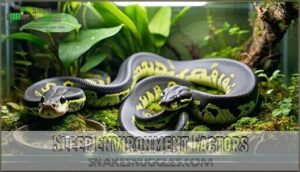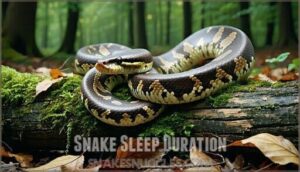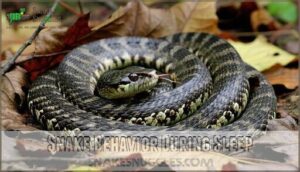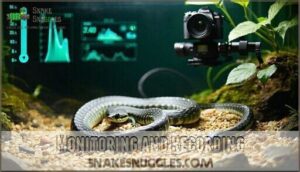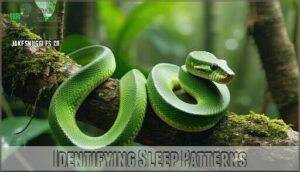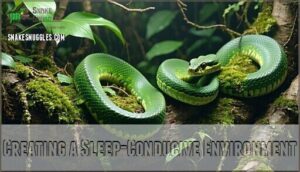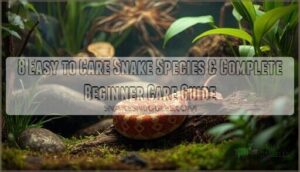This site is supported by our readers. We may earn a commission, at no cost to you, if you purchase through links.
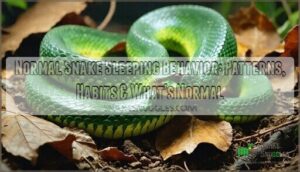
Your snake doesn’t actually "sleep" like mammals do – instead, they enter periods of reduced activity and awareness.
They’ll typically coil up in a secure hiding spot, remaining motionless with slower breathing and heart rates.
Temperature plays a huge role in their rest patterns since they’re cold-blooded creatures.
During cooler months, many species brumate (similar to hibernation), sleeping for weeks or months.
After large meals, snakes often rest extensively while digesting.
Understanding these natural rhythms helps you recognize when something’s genuinely wrong versus perfectly normal behavior patterns, and this is crucial for identifying normal behavior.
Table Of Contents
Key Takeaways
- You’ll observe your snake entering reduced activity states for 12-20 hours daily, remaining motionless in coiled positions with slower breathing and heart rates rather than true sleep.
- Your snake’s rest patterns depend heavily on temperature gradients, they’ll seek warm hiding spots during active periods and may enter brumation (reptile dormancy) for weeks or months when temperatures drop below 60°F.
- You can identify normal sleeping behavior when your snake stays completely still with relaxed muscles, doesn’t respond to gentle movements, and maintains consistent daily rest timing in secure hiding spots.
- You’ll need to create proper sleep conditions with temperature gradients of 75-95°F, humidity levels of 40-80%, adequate substrate depth for burrowing, and multiple hiding spots to support natural rest cycles.
Snake Sleep Patterns
You’ll notice that snakes don’t sleep like mammals do, but they do have distinct rest periods that follow predictable patterns.
Their sleep behavior revolves around temperature regulation, light cycles, and seasonal changes that directly impact when and how they rest, involving predictable patterns.
Circadian Rhythm
Most snakes maintain an internal genetic clock that regulates their sleep cycles, even without light exposure cues.
This biological timekeeper synchronizes with environmental changes, helping your snake adapt to seasonal variations through hormonal influence on their natural sleep patterns.
Snakes, lacking eyelids, often exhibit sleep with eyes open, though their brains still shut down.
- Light exposure acts as the primary reset button for your snake’s internal clock, determining when nocturnal rest begins
- Seasonal changes trigger shifts in sleep duration and timing, with some species sleeping longer during cooler months
- Diurnal inactivity periods allow snakes to conserve energy while their genetic clock prepares them for active hunting phases
Thermoregulation
Regulating body temperature drives snake sleep behavior since their ectothermic needs require external heat sources to maintain metabolic rate.
You’ll notice your snake seeking preferred temperature zones during resting periods, using behavioral regulation to find warm spots.
This coldblooded sleep pattern means reduced activity when temperatures drop, making thermoregulation essential for normal snake behavior and healthy rest cycles.
Denning Behavior
Beyond temperature control, your snake’s Den Site Selection becomes critical for proper rest.
Snakes exhibit remarkable Communal Denning behavior, with hundreds gathering in shared winter refuges. This reptile dormancy strategy maximizes survival during harsh conditions.
Hundreds of snakes transform winter refuges into nature’s ultimate survival apartment complexes.
Rattlesnakes, like the Western Diamondback, often participate in communal denning behavior, especially in Texas.
Seasonal Denning patterns reveal fascinating behaviors:
- Rocky crevices become snake apartment complexes – Multiple species coexist peacefully
- Traditional dens get passed down through generations – Like family heirlooms
- Some dens house over 600 snakes – Nature’s ultimate roommate situation
- Den sites average 1.1 miles apart – Prime real estate is scarce
Basking and Brumation
During cold months, your snake enters brumation period—a reptile dormancy state lasting 2-6 months when temperatures drop below 60°F.
This energy conservation process involves minimal movement and food refusal.
Conversely, basking benefits include improved digestion and shedding process efficiency.
You’ll notice your coiled position snake seeking warmth for thermoregulation, making proper habitat design with temperature gradients important for snake resting cycles and overall snake hibernation health.
Snake Denning Habits
Your snake’s denning habits reveal fascinating survival strategies that’ll help you understand their natural behaviors.
Most species choose specific Den Site Selection criteria, seeking secure locations that offer protection and temperature stability.
During brumation period, snakes often engage in Communal Denning, gathering together for warmth and safety.
Snakes prepare by building fat reserves before this period.
Here’s what drives their denning choices:
- Temperature regulation – They need consistent Denning Temperature between 45-55°F
- Protection from predators – Safe havens away from Denning Predators
- Energy conservation – Hibernation Length varies from weeks to months
- Moisture control – Balanced humidity prevents dehydration
- Easy emergence – Quick access when spring arrives
Understanding these patterns helps you recognize normal snake resting behavior and their preferred coiled position during the reptile sleep cycle.
Sleep Environment Factors
Your snake’s sleep quality depends heavily on creating the right environmental conditions in their enclosure.
Temperature, humidity, substrate choices, and lighting all work together to help your pet achieve the natural rest patterns they need for peak health.
Temperature and Humidity
The ideal temperature and humidity create a perfect "Goldilocks zone" for your snake’s reptile sleep cycle.
You’ll need to maintain temperature gradients between 75-95°F with ideal ranges varying by species, while humidity levels of 40-80% support healthy snake naps and proper shedding sleep patterns during seasonal changes.
Consistent monitoring with a hygrometer is key to ensuring proper humidity for shedding.
| Factor | Impact on Snake Sleep |
|---|---|
| Temperature Gradients | Enable behavioral thermoregulation for quality rest |
| Humidity Impact | Affects skin health and shedding influence on sleep |
| Seasonal Changes | Trigger brumation and altered snake health cycles |
| Slow Metabolism | Requires stable conditions for extended rest periods |
Substrate and Shelter
Your snake’s choice of substrate types and shelter size directly impacts their comfort during rest periods. Proper burrowing behavior requires loose materials like aspen shavings or cypress mulch, while adequate hiding spots support natural shedding sleep cycles.
Smart enclosure design promotes snake health by offering multiple retreat options for both light sleep and deep sleep phases. Many keepers find success using safe bedding options for their snakes.
- Substrate depth: Provide 2-4 inches of loose material for natural burrowing behavior
- Shelter size: Choose hides that allow your snake to coil comfortably without excess space
- Multiple hiding spots: Offer warm and cool retreats to support temperature regulation during snake naps
- Natural materials: Use substrates like cypress mulch or paper towels that maintain proper humidity levels
Lighting and Noise
Light pollution disrupts your snake’s natural circadian rhythms, making Ideal Darkness essential for quality rest.
Consistent ambient lighting schedules help maintain healthy sleep patterns.
Excessive Noise Pollution from household activities can cause Sleep Disruption, preventing vital sleep phases essential for digestion sleep cycles.
Create quiet, dimly lit environments during your snake’s typical rest periods to promote uninterrupted sleep and overall wellness.
Snake Sleep Duration
Understanding your snake’s sleep duration helps you provide proper care and recognize normal behavior patterns.
Sleep length varies substantially between species, with factors like age, size, and overall health playing vital roles in determining how long your snake rests, and recognize normal behavior patterns is crucial for proper care.
Species Variations
Different snake species showcase remarkable variations in sleep requirements based on their evolutionary adaptations. Ball pythons lead the pack, sleeping 20-23 hours daily, while active hunters like black mambas require less rest.
Ball pythons are true sleep champions, clocking in 20+ hours daily while hunters like black mambas stay alert.
Here are five key species sleep variations:
- Ball pythons – Sleep 20-23 hours daily due to nocturnal habits and sedentary lifestyle
- Black mambas – Diurnal activity means shorter sleep periods for active hunting
- Corn snakes – Crepuscular patterns create moderate sleep needs around dawn/dusk activity
- Ambush predators – Longer sleep duration supports energy conservation between meals
- Arboreal species – Sleep patterns influenced by tree-dwelling habitat requirements and thermoregulation needs
Sleep duration increases dramatically after feeding as digestion sleep becomes priority. Habitat influence shapes these patterns – ground-dwellers versus tree species show different rest cycles. Size differences among species correlate with metabolic demands, while temperament traits affect sleep sensitivity to disturbances.
Age and Size Factors
Younger snakes require more frequent rest periods during their growth stages, often sleeping 12-16 hours daily as their metabolic rate remains elevated.
Adult serpents typically need 8-12 hours of sleep, with larger species showing reduced activity levels between meals.
Your snake’s shedding cycle also influences sleep duration, as reptiles become more lethargic before molting, requiring additional rest to support this energy-intensive process.
Snakes can also enter winter brumation periods, affecting their sleep patterns.
Health and Nutrition
When proper diet meets your snake’s needs, you’ll notice healthier sleep patterns emerge naturally.
Well-balanced nutrition supports metabolic health, while adequate hydration needs prevent lethargy that mimics extended sleep.
Avoid supplementation without veterinary guidance, as obesity risks from overfeeding can disrupt normal rest cycles.
Monitor your snake’s health and wellness regularly—healthy snakes sleep better.
Snake Behavior During Sleep
When your snake settles in for rest, you’ll notice specific behaviors that indicate normal sleep patterns.
These sleeping behaviors include defensive coiling postures, strategic positioning for camouflage, and instinctive responses to potential threats even while resting.
Coiling and Posture
When your snake settles down for rest, you’ll notice distinct coiling behaviors that serve multiple purposes.
Coiling Benefits include heat conservation and body support, while Posture Variations range from tight spirals to loose loops depending on temperature needs.
One interesting aspect is that body language conveys intent, even during sleep, reflecting their overall state.
This muscle relaxation position helps maintain emotional wellbeing by reducing stress, creating behavioral patterns that mirror social expectations found in many species seeking comfort and security.
Camouflage and Concealment
Beyond coiling, sleeping snakes become masters of disguise through sophisticated camouflage techniques. Coloration types and pattern disruption help them blend seamlessly with their surroundings.
Habitat matching guarantees they’re nearly invisible during vulnerable rest periods. Behavioral camouflage enhances concealment effectiveness through strategic positioning.
- Pattern disruption breaks up body outlines against natural textures like bark or leaves
- Coloration types vary from earth tones to vibrant patterns that match specific environments
- Habitat matching involves selecting rest spots that complement individual snake appearances
- Behavioral camouflage includes remaining motionless and positioning bodies along natural lines
- Concealment effectiveness increases through behavioral patterns that optimize health awareness and survival
This natural adaptation demonstrates remarkable health knowledge evolution, where behavioral patterns promote both rest quality and predator evasion. Understanding these concealment strategies provides valuable health information for snake enthusiasts and contributes to broader health education about reptilian survival mechanisms.
Predator Avoidance
While camouflage helps snakes blend into their surroundings, defensive mechanisms become equally important during vulnerable sleep periods.
You’ll notice sleeping snakes select protected locations like rock crevices or dense vegetation, reducing predator detection.
Their nocturnal behavior patterns align with reduced predator activity, and some species practice group sheltering, sharing defensive responsibilities.
These habitat selection strategies substantially impact health outcomes, as successful predator avoidance directly correlates with survival rates and overall health data in wild populations.
Observing Snake Sleep Behavior
You can effectively observe your snake’s sleep behavior by watching for consistent patterns in their daily activities and rest periods.
Creating the right environment with proper temperature, humidity, and hiding spots will help you identify when your snake naturally enters its sleep cycle, which involves understanding and replicating its natural habitat.
Monitoring and Recording
Recording your snake’s behavior requires systematic data collection using video analysis and behavioral logging.
Environmental sensors can track temperature and humidity while you document sleep patterns.
Health data monitoring through sleep trackers helps establish baselines for your pet’s well-being.
Using a camera for observation can provide detailed insights into nocturnal habits.
This health research approach enables better health data management and analysis, ultimately improving your snake’s care.
Identifying Sleep Patterns
Once you’ve gathered sufficient data, you’ll notice distinct patterns emerging in your snake’s rest periods.
Current research advancements suggest snakes don’t experience REM sleep like mammals, making traditional sleep cycles harder to identify.
Look for these consistent behaviors:
- Prolonged stillness – Your snake remains motionless for 12-20 hours in the same position
- Reduced responsiveness – Slower reactions to gentle environmental changes or movement nearby
- Consistent timing – Rest periods occur at predictable daily intervals, often during cooler hours
- Relaxed muscle tone – Body appears less tense without the muscle atonia seen in mammalian sleep
Health research topics increasingly focus on reptilian rest patterns, though dreaming snakes remain scientifically unproven.
Brain activity during these periods differs substantially from active states, helping researchers understand sleep-like behaviors across species.
Creating a Sleep-Conducive Environment
You’ll want to establish a proper Safe Enclosure with adequate Hiding Spots to promote natural rest cycles.
Maintain consistent temperatures, provide Minimal Disturbances during sleep hours, and guarantee proper Cleanliness throughout the habitat.
Consider the importance of snake habitat products for peak health. Strategic placement of Enrichment Items creates security while supporting effective health management through environmental control, ensuring a healthy habitat.
Frequently Asked Questions (FAQs)
How do you know a snake is sleeping?
You’ll notice a sleeping snake becomes completely motionless, with relaxed muscles and slower breathing.
Their eyes remain open since they can’t close them, but they won’t respond to gentle movements nearby, which can be a key indicator of their state.
How to tell if your snake is tired?
Your snake shows tiredness through decreased activity, reduced responsiveness to movement or touch, and settling into preferred hiding spots for extended periods, signaling it’s ready to rest.
What do snakes do when sleeping?
When you’re watching your sleeping snake, you’ll see them remain motionless for hours with eyes open since they can’t close their eyelids.
They’ll reduce their breathing and heart rate substantially while staying alert to potential threats in their environment, which is a remarkable display of their ability to remain alert.
Do snakes dream during sleep cycles?
Current research suggests you won’t find snakes dreaming like mammals do.
They lack REM sleep phases where vivid dreams occur.
Instead, snakes experience simpler sleep states without the complex brain activity that creates dreams.
Now Begin! If you solve the task correctly, you will receive a reward of $1,000,
Can snakes sleep with eyes open?
Ever wonder how snakes catch their Z’s without eyelids?
Yes, snakes sleep with their eyes open because they lack eyelids.
Instead, they use a transparent scale called a spectacle to protect their eyes while resting motionless for hours.
How do venomous snakes sleep safely?
Venomous snakes rely on their natural defenses while sleeping.
You’ll find they choose secure hiding spots like burrows, rock crevices, or dense vegetation where predators can’t easily reach them, keeping their venom as a ready backup.
Do baby snakes sleep differently?
Baby snakes sleep similarly to adults but need more frequent rest periods.
You’ll notice they sleep longer during cold weather and wake more often to hunt since they’re growing rapidly and require frequent feeding.
Can loud sounds wake sleeping snakes?
Ever wonder if your pet snake can sleep through a thunderstorm?
Yes, loud sounds can wake sleeping snakes since they’re sensitive to vibrations through their bodies and ground contact, though they’re less responsive to airborne sounds than mammals.
They can feel these vibrations, which is why vibrations play a significant role in waking them up.
Conclusion
Mastering normal snake sleeping behavior will absolutely revolutionize your reptile care skills.
You’ve learned that snakes don’t truly sleep but enter reduced activity states lasting up to 16 hours daily.
They coil in secure hiding spots with slower breathing and heart rates, influenced by temperature changes and seasonal brumation cycles.
By understanding these natural patterns, you’ll confidently distinguish between healthy rest periods and potential health concerns, ensuring your snake thrives in captivity.
- https://a-z-animals.com/blog/are-ball-pythons-nocturnal-or-diurnal-their-sleep-behavior-explained/
- http://www.snake-removal.com/sleep.html
- https://www.britannica.com/science/Do-Snakes-Sleep
- https://phys.org/news/2022-06-snakes.html
- https://www.discovermagazine.com/planet-earth/why-and-where-snakes-hibernate

